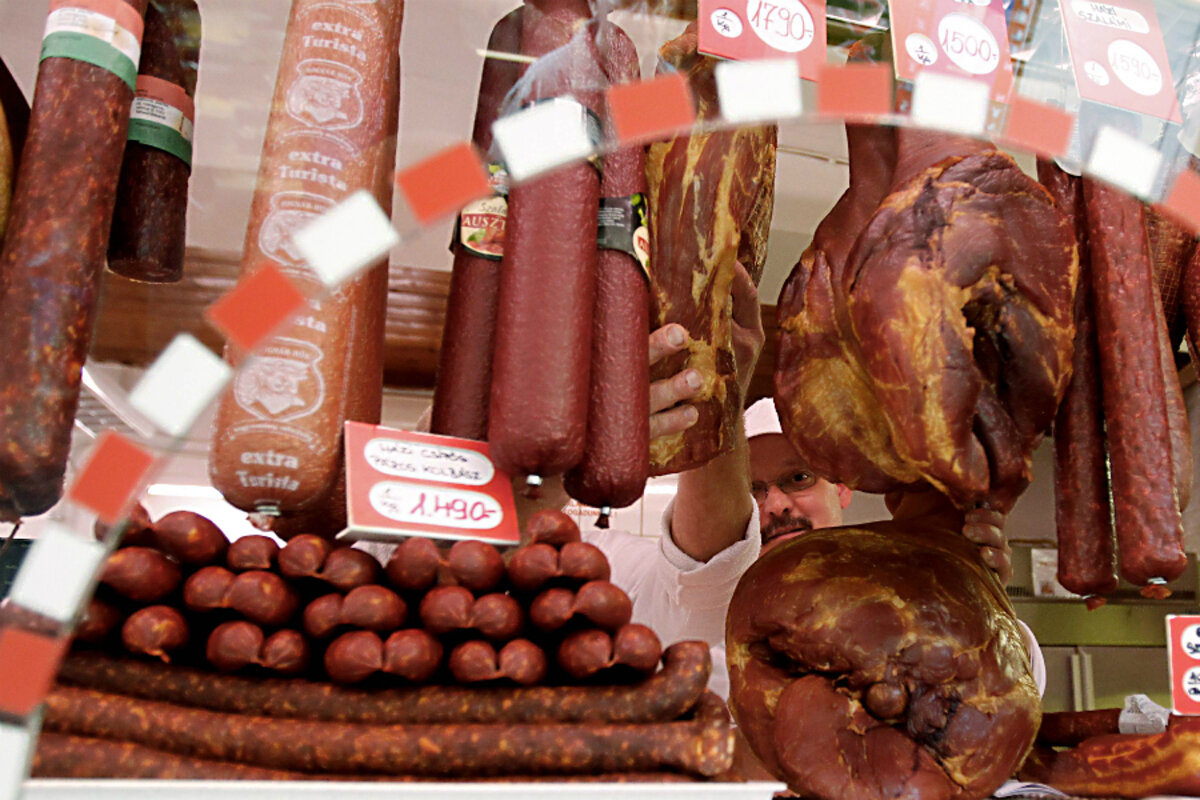Dining out in Hungary? No need to bring the salt.
Loading...
| Budapest, Hungary
Anna Kutor, unlike most Hungarians, doesn’t add a lot of salt to her cooking. So when she invited her father over for dinner recently and forgot to add it in the quantity he's used to, he looked at her and asked: “Is something wrong in your marriage?”
Hungarians like their salt so much that one of their sayings literally goes, “Salty soup means the cook is in love,” explains Ms. Kutor, the culinary guide for Taste Hungary, as she leads a group of tourists through Budapest’s cavernous Great Market Hall.
One does not need to walk far to see where the adage comes from.
First food stop: langos. It’s deep-fried sourdough bread braised with garlic and usually topped with sour cream and cheese – and heavily salted. “Everything is salty,” Kutor says. “Here we say the only thing that brings cholesterol down is a pickle at lunch.”
The group passes rows of sausages for every taste, including the coveted Winter Sausage by the company Pick Szeged – a product that Kutor swears every expatriate Hungarian dreams of. Behind the counter are thick slabs of bacon fat. “One of these will be in every pantry in Hungary,” Kutor says. As summer approaches it will be sliced and roasted over fires the way Americans roast marshmallows.
It’s delicious, she swears. But it also causes a problem: Hungarians have some of the highest intake of sodium across Europe. One study from 2009, the most recent available statistics, showed that Hungarian men consume 17.5 grams of salt per day, by far the highest rate within the European Union. Women were up there, too, with 12.1 grams per day. The global average of daily salt intake is around 10 grams, and the World Health Organization (WHO) recommends it be no more than 5.
So the Hungarian government moved in 2011 to implement a tax on foods containing unhealthy amounts of salt, sugar, and caffeine. The WHO concluded – most recently in January – that the tax has had an impressive impact, with 40 percent of responding manufacturers changing their food formulas to reduce their tax burden within a year. Products that were subject to the taxes decreased by 27 percent, while consumers said they ate between 25 and 35 percent fewer of any product that would be subject to the tax. Today, the government maintains it’s one of the most successful healthcare initiatives taken under Prime Minister Viktor Orban.
But in the Great Market Hall, it’s obvious that old habits die hard. Despite a new movement, mostly in the capital, to offer modern, sleeker versions of Hungarian classics, it’s still such staples as goulash that define the national palette. Carolyn Banfalvi, who founded Taste Hungary with her husband, is fascinated by the culinary traditions in this region of Europe, from the paprika-infused dishes to velvety red wines, but still, Hungarian food “is not really healthy,” as she puts it. “It is meat-focused. Uses a lot of fat in the cooking. And lots of sour cream.”
And while savory food is more prevalent in the national diet than sweets, Hungarians have a hankering for sugar, too.
In addition to the langos, sausage, and pickle stalls at Budapest's central market is one for strudel, where a man rolls out giant rectangular sheets of dough that are then filled with poppy seeds, sour cherries, and apples.
Kutor looks no further than her family to describe this vice, opening up a candy bar, called the Turo Rudi, that has been a favorite afternoon snack here since 1968. “My daughter loves these,” she says of the treat, which consists of a thin coating of chocolate with a curd filling. “It’s cottage cheese. That’s health food, right?”





